
Varisia
The Player's Guide, which contains more information on the people, religions, beasts etc. of Varisia, is free to download at Paizo.
Scarred by the depravity of ancient wizards and reclaimed
by a wilderness of beasts and savages, only in the past few
hundred years have the steps of civilized men again trod
the wondrous and mysterious lands of Varisia.
From the reclusive elves of the Mierani forest to the orc-blooded
interlopers from the Hold of Belkzen to the Varisian wanderers
from whom the region takes its name, diversity and conflict
characterize the varied cultures that make Varisia their home.
Languages include Taldane (Common), sharp Shoanti, sultry Varisian, and Thassilonian, the dead language spoken only by intellectuals, historians and arcanists.

People
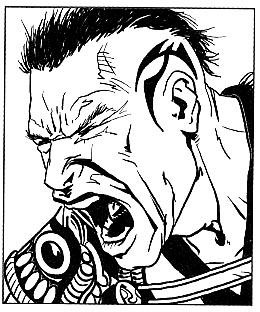
Humans
Humans are by far the most common race in Varisia, and generally
fall into one of three ethnicities—the cultured Chelaxians of
the cities, the nomadic Varisians, or the fiercely tribal Shoanti
barbarians. Chelaxians tend toward dark hair and eyes and pale skin. Popular opinion holds that most Varisians are singers, storytellers and thieves. They carry special scarves called kapenia, but only wear them on special occasions. They never brook insults to their ancestors or clan leaders. They have olive skin and dark hair. Shoanti are a proud people divided into 7 clans, or quahs: the Lyrune-Quah (Moon Clan), Shadde-Quah (Axe Clan), Shriikirri-Quah (Hawk Clan), Shundar-Quah (Spire Clan), Sklar-Quah (Sun Clan), Skoan-Quah (Skull Clan), and Tamiir-Quah (Wind Clan). They are tall, powerfully built and tend to have ruddy complexions.
Elves
The elves, recently returned from an age-long absence,
are far taller and thinner than humans, with long pointed ears and
pupils so large they fill much of the eye. Most elves keep to their
own kind, preferring the wild places where, over time, they take
on aspects of their environment. Occasionally a traveler in Varisia
might run into one of the Forlorn—lonely elves who grew up in
non-elf lands among folk who are born and die in the time it takes
an elf to reach maturity. Elves left the world on the eve of the Earthfall, returning en masse in the middle of the Age of Enthronement. They generally have four names.
Dwarves
Dwarves in Varisia are stocky miners and stalwart fighters,
generally concentrated around their stronghold of Janderhoff. They see elves as weaklings who abandoned the world during the Age of Darkness, and half-orcs as savage curs, progeny of a race they've been at war with for millenia.
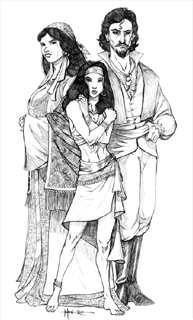
Halflings
Halflings, in contrast, are nomadic and have no set homeland,
preferring instead to latch onto other races and wedge themselves
into the cracks in any given society.
Gnomes
Gnomes are by far the most
mysterious and magical of the civilized races, and their vibrantly
colored hair and skin show the influence of nature and their
fey roots. While gnomes are generally no more evil than the
other races, their alien thought processes and adherence to an
unconventional moral code tend to make other races uneasy. Gnomes need excitement on a regular basis or they suffer the Bleaching, losing color, substance and awareness until they die. It is the only natural cause of death among them. They emerged from the First World.
Half-breeds
Half-breeds such as half-elves and half-orcs are exceedingly
rare in Varisia. Half-elves, with their extended
lifespan, face many of the same problems and prejudices as
the Forlorn, while half-orcs are almost universally mistrusted by
all but their orc brethren. (True orcs, for their part, frequently
conduct raids into human lands specifically to breed more halforcs,
as the smarter half-breeds make the best leaders of the
various orc tribes.) Half-elves have an affinity for crystals, while half-orcs often collect tattoos.
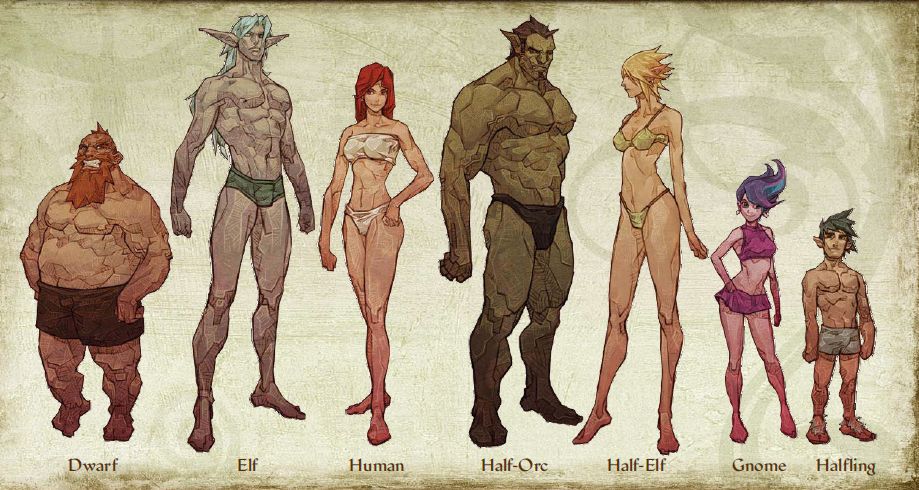

Religion
The civilized peoples of Varisia most
commonly worship one of six deities: Abadar,
Desna, Erastil, Gozreh, Sarenrae, and Shelyn.
The region’s Varisian wanderers possess
a strong traditional belief in Desna, while the
Shoanti revere abstract powers of nature,
their ancestors, and tribal totems.
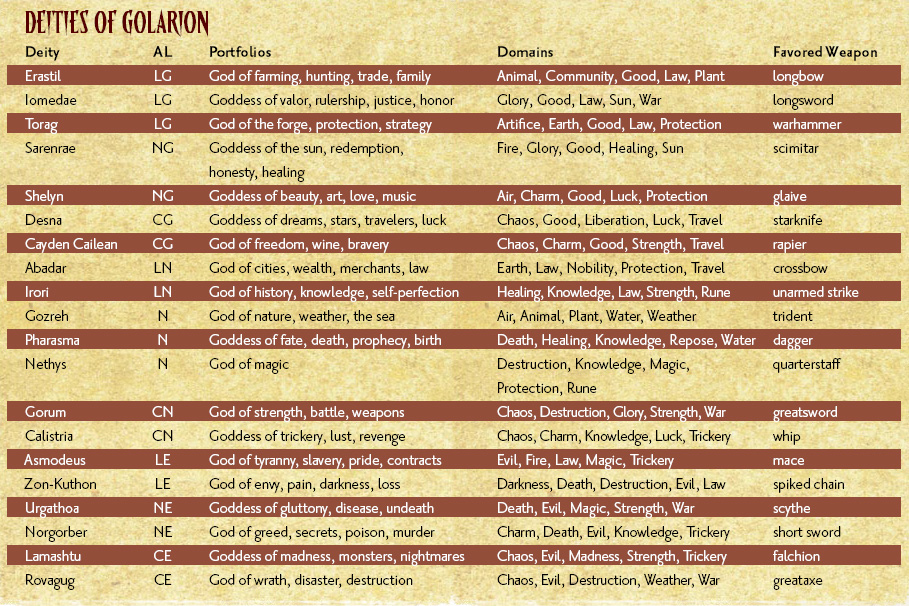

Bestiary
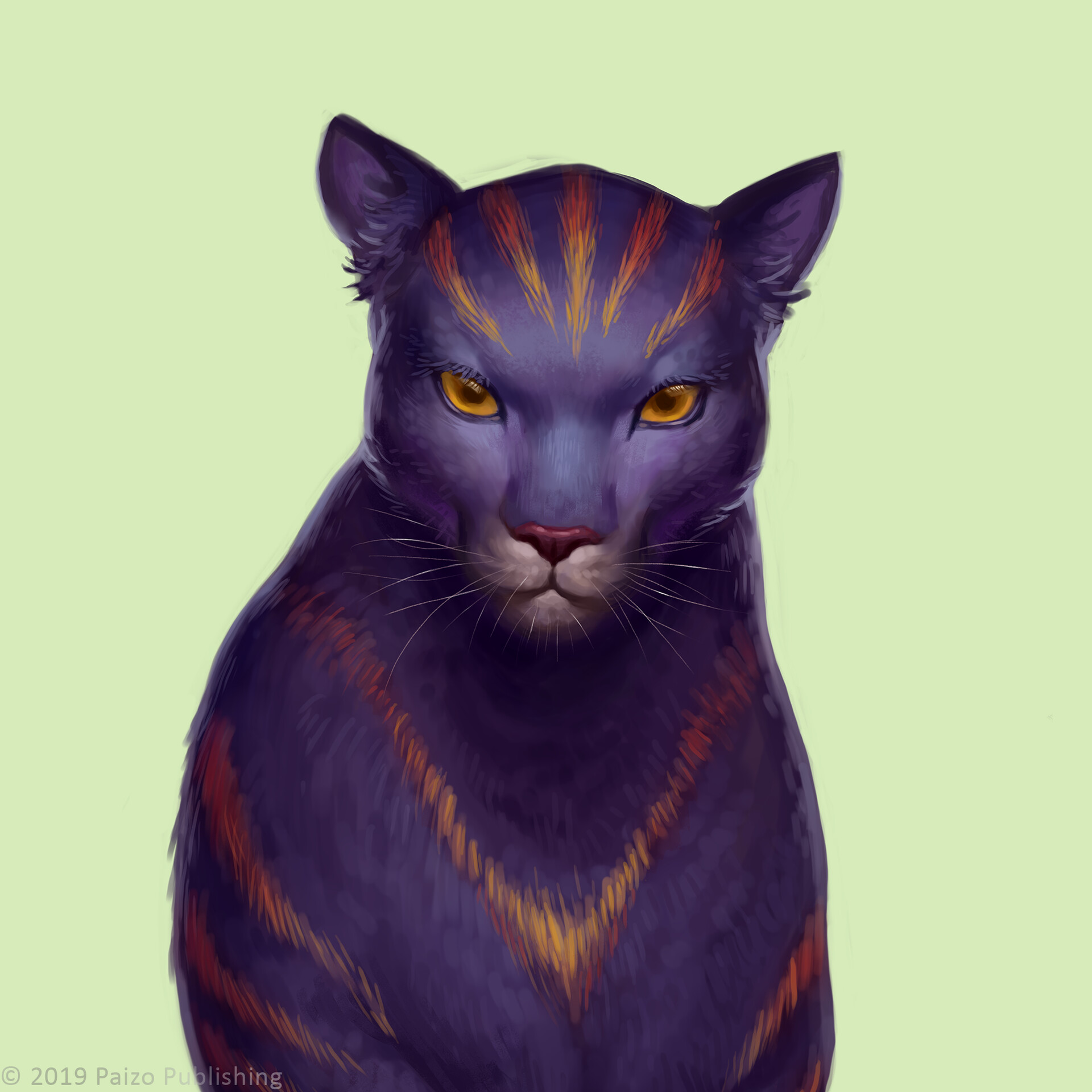 Cindersnake: These giant red-patterned
vipers hide amid the crags and fine silt of the Cinderlands,
crippling prey with a painful, burning venom.
Cindersnake: These giant red-patterned
vipers hide amid the crags and fine silt of the Cinderlands,
crippling prey with a painful, burning venom.
Donkey Rat: Snowy white rodents the size of small dogs
(in some places known as capybaras or giant guinea pigs), the
donkey rats native to Varisia’s coast are popular pets (and meals)
throughout the southern lands.
Fire Pelt: These black-and-red-furred mountain lions stalk much
of northwestern Varisia. The color of their pelts changes from predominantly
black to a range of autumnal colors with the seasons.
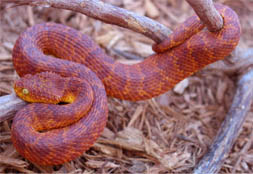
Giant Lizard: Geckos the size of ponies prowl the moist sea
cliffs and forests of southern Varisia, feasting on rodents, giant
insects, and even the occasional goblin. Upon
the Storval Plateau, aggressive horned spirestalker lizards hide
among rocky outcroppings and fearlessly attack anything that
comes in sight.
Storm Roc: Proud raptors with wings the color of thunderheads
and crownlike crests of tousled feathers, storm
rocs are said to live for hundreds of years and eventually
grow to the size of the true rocs.

Calendar
Download the AR 4707 calendar
Years are marked since the founding of the last great
empire by Aroden, the Last Man. Although the empire has
collapsed, its calendar remains in use to this day. At the
start of Rise of the Runelords, the date is 4707 AR
(Absalom Reckoning).
The days of the week are as follows. Each day has a general
purpose that most people in the Inner Sea region follow.
| Weekdays
|
| Moonday
|
Work, religion (night)
|
| Toilday
|
Work
|
| Wealday
|
Work
|
| Oathday
|
Work, pacts signed, oaths sworn
|
| Fireday
|
Work
|
| Starday
|
Work
|
| Sunday
|
Rest, religion
|
The months in Golarion correspond to our own, with each
new year starting shortly after the solstice. Each month
is etymologically tied to a specific god—residents of
Golarion see the gods reflected in the changing of the
seasons, and their names for the months reflect this.
| Months
|
| Abadius
|
Calistril
|
Pharast
|
Gozran
|
Desnus
|
Sarenith
|
Erastus
|
Arodus
|
Rova
|
Lamashan
|
Neth
|
Kuthona
|
| January
|
February
|
March
|
April
|
May
|
June
|
July
|
August
|
September
|
October
|
November
|
December
|

Coins
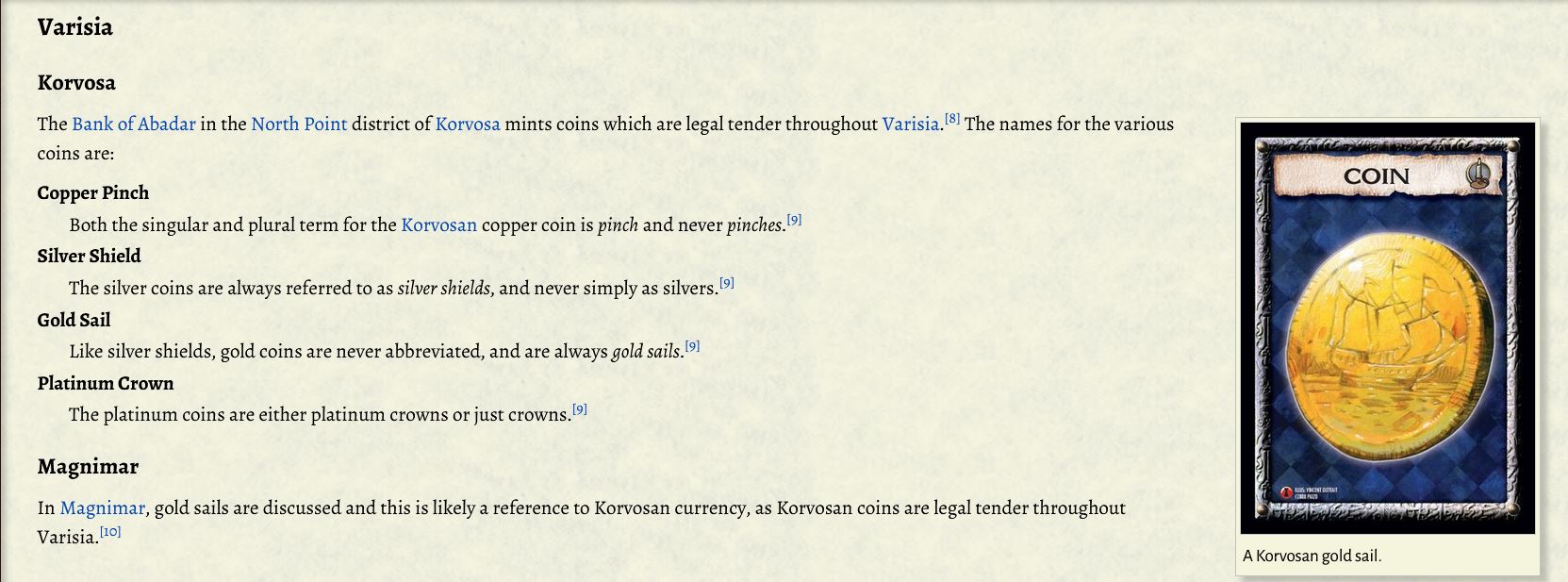

The Lost Coast
Those who head north from Magnimar along the rocky coastline quickly find themselves
in a peculiar country. Fog drapes the rolling landscape, floating spectrally along damp
and lonely moors. Small woodlands grace the region, their tangled depths redolent of
nettles and pepperwood and pine sap, while further inland, river valleys lined by majestic
redwoods wind between ragged tors and limestone escarpments. This vastness and
the sense of isolation have earned the region its local name. This is the Lost Coast.
Yet there are pockets of civilization along the Lost Coast. Traditional
Varisian campsites can be found in nearly every gulch and
hollow along the cliff-lined reaches, and lonely houses sit upon
bluffs now and then - domiciles for eccentrics or the rich seeking
a bit of peace far from the bustle of Magnimar’s streets. Roadside
inns grace the Lost Coast road every 24 miles or so, placed by
virtue of the distance most travelers can walk given a day’s travel.
Low stone shrines to Desna, goddess of wanderers and patron of
the Varisians, give further opportunities for shelter should one of
the all-too-common rainstorms catch the traveler unaware. Given
time, any of these seeds of civilization could bloom into a full-grown
town, or even a city. It’s happened once already, along the
shores of a natural harbor nestled among the cliffs some 50 miles
northeast of Magnimar. What was once a larger-than-normal Varisian
campsite in the shadow of an ancient ruined tower has become
the Lost Coast’s largest town: Sandpoint.

Sandpoint
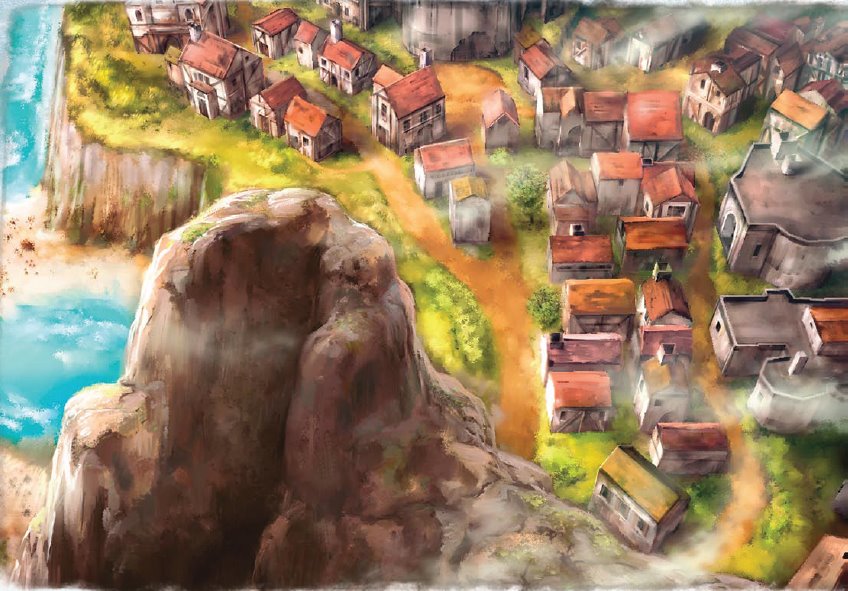
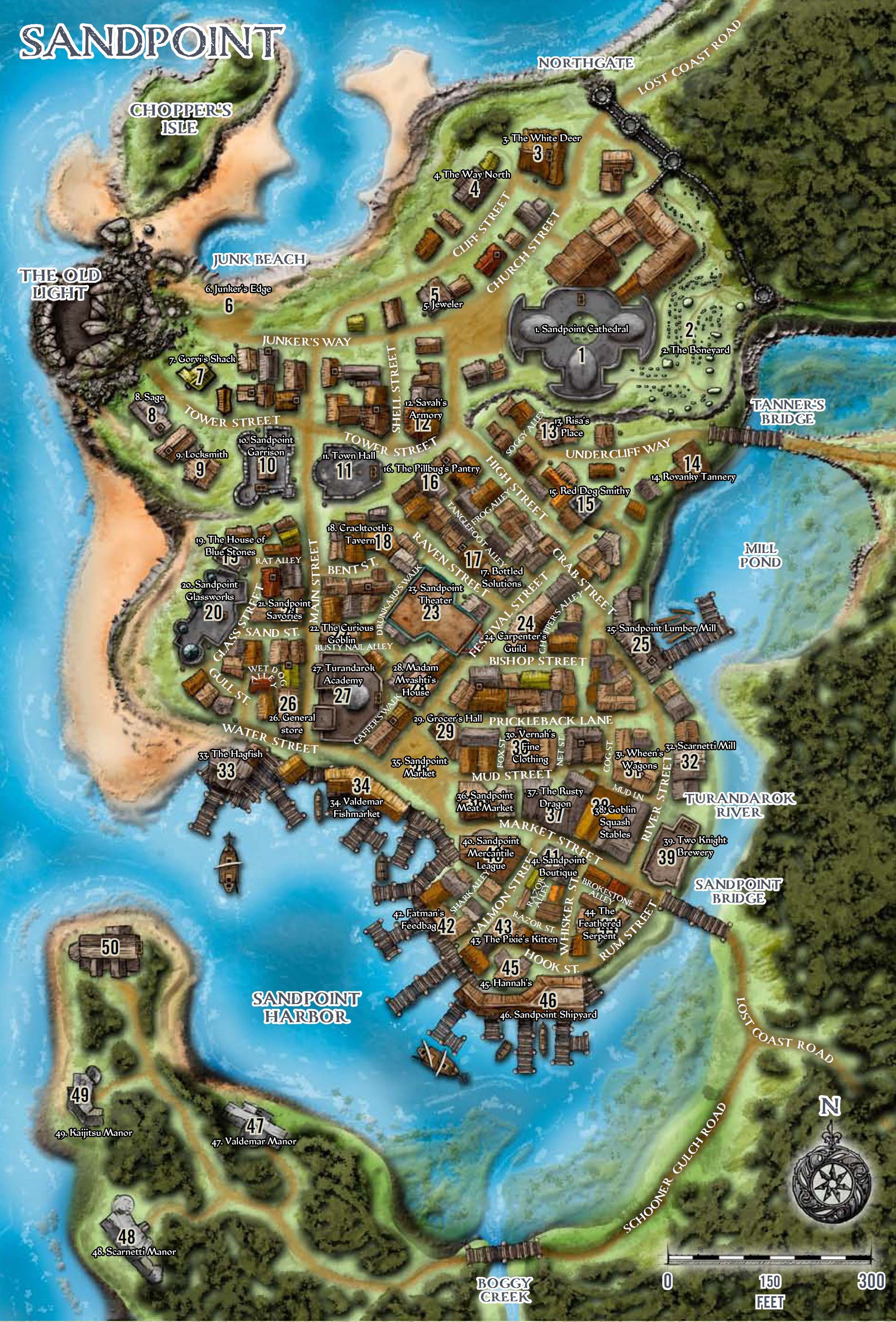 As one approaches the town of Sandpoint, the footprint of civilization
upon the Lost Coast grows more clear. Farmlands in the
outlying moors and river valleys grow more numerous, and the
blue-green waters of the Varisian Gulf bear more and more fishing
vessels upon its surface. Passage over creeks and rivers is more
often accomplished by wooden bridge than ford, and the Lost
Coast Road itself grows wider and better-kept. Sight of Sandpoint
from either approach (south or east) is kept hidden by the large
upthrust limestone pavements known as the Devil’s Platter or the
arc of rocky outcroppings known as Whistler’s Tors, but as the final
bend in the road is rounded, Sandpoint’s smoking chimneys and
bustling streets greet the traveler with open arms and the promise
of warm beds, a welcome sight indeed for those who have spent the
last few days alone on the Lost Coast Road.
As one approaches the town of Sandpoint, the footprint of civilization
upon the Lost Coast grows more clear. Farmlands in the
outlying moors and river valleys grow more numerous, and the
blue-green waters of the Varisian Gulf bear more and more fishing
vessels upon its surface. Passage over creeks and rivers is more
often accomplished by wooden bridge than ford, and the Lost
Coast Road itself grows wider and better-kept. Sight of Sandpoint
from either approach (south or east) is kept hidden by the large
upthrust limestone pavements known as the Devil’s Platter or the
arc of rocky outcroppings known as Whistler’s Tors, but as the final
bend in the road is rounded, Sandpoint’s smoking chimneys and
bustling streets greet the traveler with open arms and the promise
of warm beds, a welcome sight indeed for those who have spent the
last few days alone on the Lost Coast Road.
The sight that strikes all visitors to Sandpoint at first is the ruins
of the Old Light. The Old Light rises from
sea level and is built into the face of a 120-foot-tall cliff , the tower
extending another 50 feet above that level to culminate in ragged
ruins.
From the south, entrance to Sandpoint is governed by a wooden
bridge, while from the north a low stone wall gives the town a bit
of protection. Here, the Lost Coast Road passes through a stone
gatehouse that is generally watched by one or two guards - the
southern bridge is typically unattended. Aside from the occasional
goblin, the citizens of Sandpoint have traditionally had little worries
about invasion or banditry - the region simply isn’t populated
enough to make theft a lucrative business. Hanging from a bent nail
at both the gatehouse and the southern bridge is a sign and a mirror -
painted on each sign is the message: “Welcome to Sandpoint!
Please stop to see yourself as we see you!”
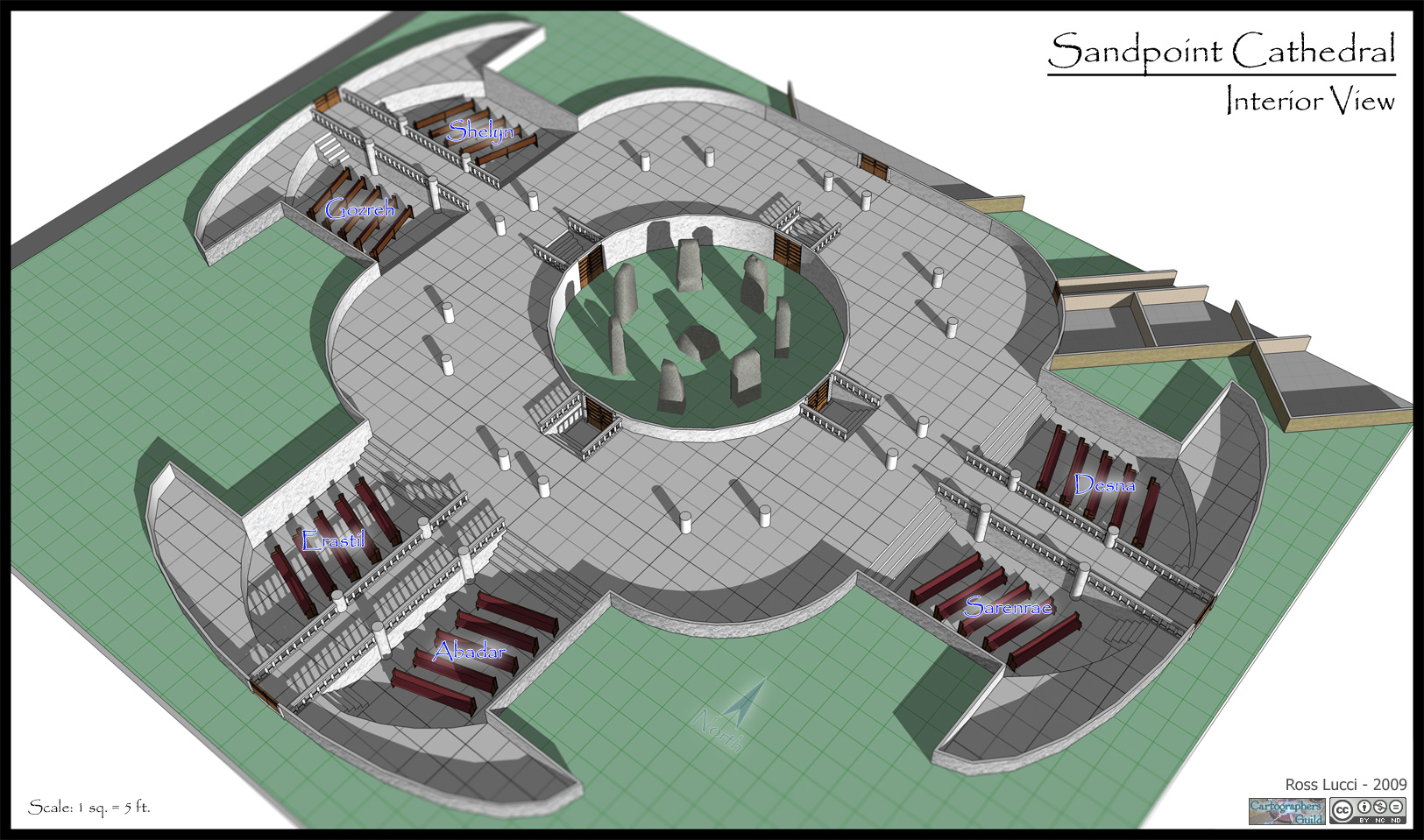
1. Sandpoint Cathedral
Easily the largest building in Sandpoint, this impressive cathedral
is also the town’s newest structure. Built over the foundations of
the previous chapel, Sandpoint Cathedral is not dedicated to the
worship of a single deity. Rather, it gathers under its eaves the six
most commonly worshiped deities in the region, providing chapels
for all of these deities in a communal forum. In a way, Sandpoint
Cathedral is six different churches under one impressive roof.
Yet even the previous chapel wasn’t the first holy site in this location.
The core of both the original chapel and the new cathedral is an
open-air courtyard surrounding a set of seven standing stones themselves
surrounding a circular stone altar.
To the south, facing Sandpoint’s heart, are the shrines
of civilization: Erastil and Abadar. To the west, offering a view of
the Old Light and the sea beyond, are the shrines of Shelyn and
Gozreh. And to the east, off ering a view of the Sandpoint Boneyard
and the rising sun, are the shrines of Sarenrae and Desna.
2. Sandpoint Boneyard
Set in the shadow of the Sandpoint Cathedral and accessible via a
gate to the north or from several doors leading into the cathedral
itself, this expansive cemetery overlooks the Turandarok River.
3. The White Deer
A pair of wooden life-sized deer, carved with painstaking care from
white birch, stand astride the entrance to this sizable tavern and inn.
10. Garrison
This stone fortress serves double duty as Sandpoint’s militia barracks
and its jail. The jail itself is located in an underground wing,
while the above-ground portion houses the town’s guard.
The garrison’s jailor is a heavily scarred brute
named Vachedi, a Shoanti
tribesman. The garrison is currently under the watchful eye of Sheriff Belor
Hemlock, a native Shoanti.
11. Town Hall
15. Red Dog Smithy
Here the foul-mouthed, short-tempered Das Korvut, along with his huge red mastiffs, works at the smoking smithy.
19. The House of Blue Stones
This long stone building is primarily a single large chamber, the
floor decorated with polished blue stones set within winding
pathways of reed mats. A worshiper of Irori, the god of self-perfection
and knowledge, Sabyl Sorn maintains a large collection of old books
and scrolls in the basement chambers below. She opens both
the meditation floor and her library to fellow worshipers, but
others must convince her of their good intentions before she’ll let them in. She already denied Durriken access, if very politely.
29. Grocer's Hall
34. Valdemar Fishmarket
35. Sandpoint Market
36. Sandpoint Meat Market
37. The Rusty Dragon
This large structure is Sandpoint’s oldest inn, notable for the impressive
(and quite rusty) iron dragon that looms on the building’s roof,
doubling as a lightning rod and decoration. Owned and operated
for the past six years by the lovely and popular Ameiko Kaijitsu, the Rusty Dragon is
not only one of the town’s most popular eateries (made so, in large
part, by the spicy and exotic food served here), but also a great
place to meet visitors from out of town, since most newcomers
to Sandpoint come upon this inn first, the north Lost Coast Road
being less traveled. The Rusty Dragon is probably the most
adventurer-friendly establishment in town.
38. Goblin Squash Stables
The sign above this door perpetuates one of the greatest fears of
the lowly goblin—being trampled underfoot by a horse. Tended by
a retired hunter named Daviren Hosk, in a
somewhat grisly display, over the entrance to the stable’s covered
barn is his collection of goblin ears: preserved and nailed to three
different rafters, each bearing the goblin’s name burned into the
leathery flesh.
46. Sandpoint Shipyard

|